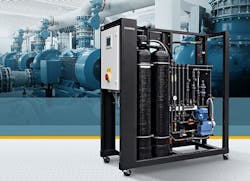The new OSEC B-Pak tubular cell electrolyzer systems from the Siemens Industry Automation Division generate up to five kilograms of chlorine per hour for disinfecting drinking, process and swimming pool water. Available in four new capacities, Osec B-Pak tubular cell electrolyzer systems from the Siemens Industry Automation Division extend the output range of the company's water disinfection portfolio. The largest model, the OSEC B-Pak 260 system, can produce up to five kilograms of chlorine per hour or 120 kilograms of chlorine per day. Producing the sodium hypochlorite as needed and onsite eliminates the dangers involved in storing and transporting chlorine gas or commercially available sodium hypochlorite solution. As it is also cheaper to operate an OSEC B-Pak system than to buy sodium hypochlorite, the initial capital cost pays off quickly.
The newly developed systems are compact and mounted on a skid to save space, easy to operate and designed for a long service life. The core component is a newly designed, especially robust electrolyzer cell in a clear acrylic enclosure that produces a stable disinfectant solution. The low-concentration solution minimizes corrosion and degradation - loss of available chlorine during storage - which occurs with highly concentrated solutions containing 10 to 15% sodium hypochlorite. Operational safety is enhanced thanks to the fully automated control system. Components are readily accessible and easy to clean. The systems are supplied completely preassembled, electrically connected and tested and can be quickly installed and commissioned onsite
Source: Siemens


